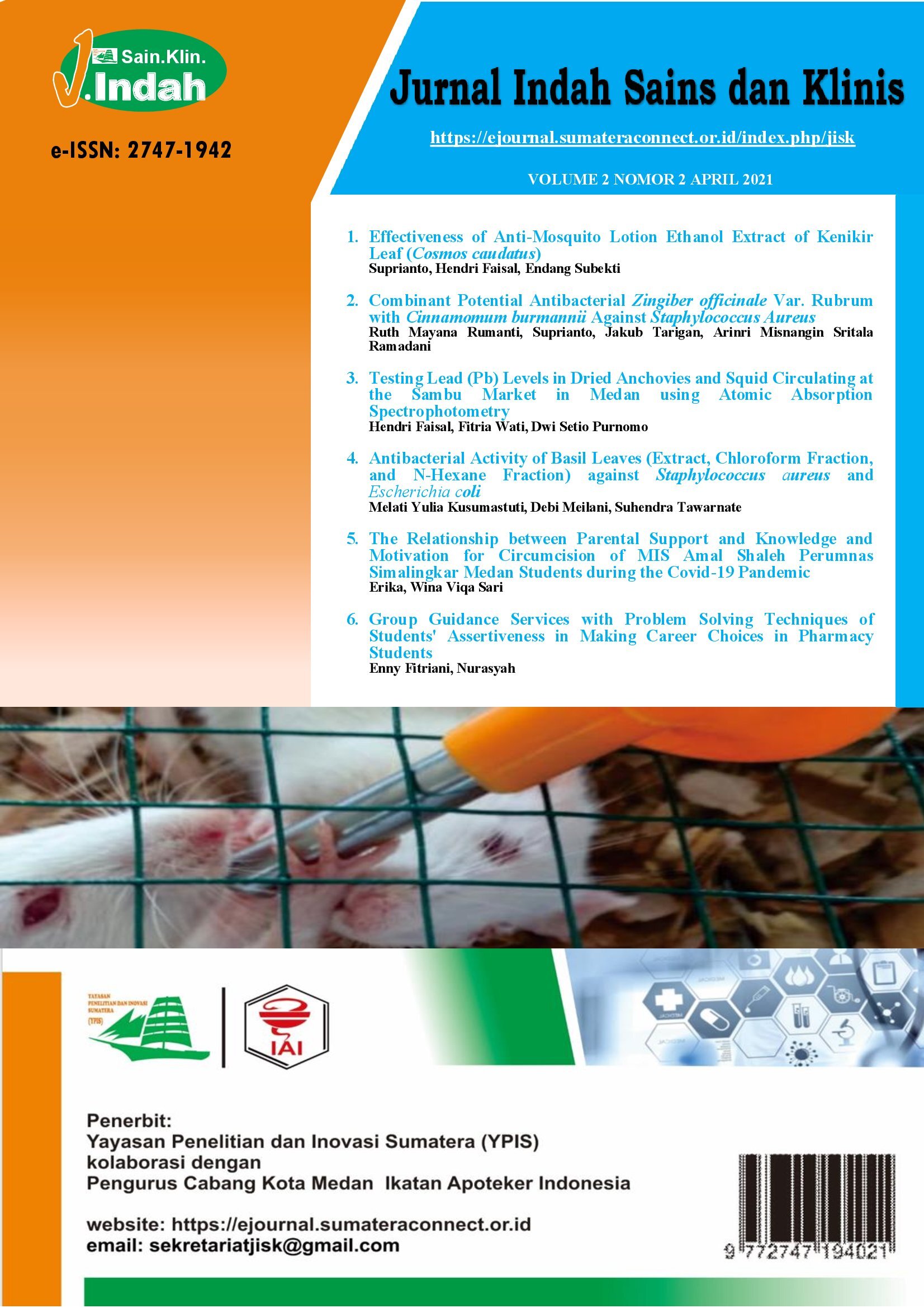Testing Lead (Pb) Levels in Dried Anchovies and Squid Circulating at the Sambu Market in Medan using Atomic Absorption Spectrophotometry
DOI:
https://doi.org/10.52622/jisk.v2i1.10Keywords:
Dried Anchovy, Dried Squid, Lead, Lead, Atomic absorption spectrophotometricAbstract
Anchovies and squid are some of the most abundant fishery resources in Indonesian waters. There is an increase in the concentration of heavy metals such as lead in marine waters which is caused by industrial waste, both solid and liquid waste, so that marine biota such as anchovies and squid accumulate these heavy metals. The very high level of heavy metal toxicity can have adverse effects on public health. The aim of this study was to determine the lead content and determine the number of levels in dried anchovies and dried squid circulating in Sambu Market, Medan City. This research used the atomic absorption spectrophotometric method at a wavelength of 283.8 nm. The results showed that dried anchovies and dried squid contained lead with the highest levelsin dried anchovies was 7.04 mg/kg and the levels in dried squid were 6.65 mg/kg. The metal content of lead in dried anchovies and dried squid has exceeded the maximum standard set by the Indonesian National Standard (SNI Number 7387 of 2009), namely 0.3 mg/kg in fish and their processed products, while 1.5 mg/kg in mollusks.
Downloads
References
Csirke J, Gulland JA. Small Shoaling Pelagic Fish Stocks. Fish Popul Dyn Implic Manag. 1988;
Uluturhan E, Kucuksezgin F. Heavy Metal Contaminants in RedPandora (Pagellus erythrinus) Tissues from The Eastern Aegean Sea, Turkey. Water Res. 2007;41(6):1185–92.
Nontji A. Laut Nusantara Edisi Revisi. Djambatan Jakarta. 2005;
Makfoeld D. Toksikan Nabati dalam Bahan Makanan. Liberty.Yogyakarta; 1983.
Palar H. Pencemaran dan Toksikologi Logam Berat. Jakarta: Rineka Cipta; 1994.
Darmono. Logam dalam Sistem Biologi Makhluk Hidup. Penerbit Universitas Indonesia; 1995.
Fardiaz S. Polusi Air dan Udara. Kanisius; 1992.
Galal‐Gorchev H. Dietary Intake, Levels in Food and Estimated Intake of Lead, Cadmium, and Mercury. Food Addit Contam. 1993;10(1):115–28.
Siboro NS, Sitorus H, Lesmana I. Analisis Kandungan Logam Berat Timbal (Pb) pada Ikan Pelagis Kecil yang Didaratkan Di Pps Belawan Kecamatan Medan Belawan Sumatera Utara. Aquacoastmarine. 2016;14(4):52–8.
IndirawatiSM. Pencemaran Logam Berat Pb dan Cd dan Keluhan Kesehatan pada Masyarakat di Kawasan Pesisir Belawan. Jumantik. 2017;2(2):54–60.
Nasional BS.SNI 7387: 2009. tentang Batas Maksimum Cemaran Logam Berat dalam Pangan Jakarta Badan Standarisasi Nas. 2009;
Indonesia SN. Cara Uji Kimia–Bagian 5: Penentuan Kadar Logam Berat Timbal (Pb) dan Kadmium (Cd) pada Produk Perikanan. SNI. 2011;2354:2011
Gandjar IG, Rohman A. Kimia Farmasi Analisis. Pustaka Pelajar, Yogyakarta. 2007;299:463–80.
Harmita H. Buku Ajar Analisis Fisikokimia. Jakarta Dep Farm FMIPA UI. 2006;
Nasional BS. Batas Maksimum Cemaran Logam Berat dalam Pangan. SNI. 2009;7387:2009.
Widajanti L, Girsang R, Pradigdo SF. Studi Keamanan Pangan Kimiawi dari Logam Berat Timbal pada Euthynnus Sp, di Perairan Semarang. J Kesehat Lingkung Indones. 2004;3(2):66–8.
Shi P, Xiao J,Wang Y, Chen L. Assessment of Ecological and Human Health Risks of Heavy Metal Contamination in Agriculture Soils Disturbed by Pipeline Construction. Int J Environ Res Public Health. 2014;11(3):2504–20.
Downloads
Published
Issue
Section
License
Copyright (c) 2024 Jurnal Indah Sains dan Klinis

This work is licensed under a Creative Commons Attribution-NonCommercial-ShareAlike 4.0 International License.









 This work is licensed under a
This work is licensed under a 
